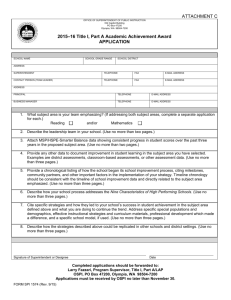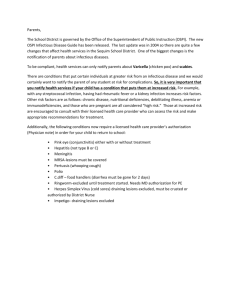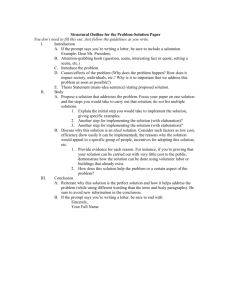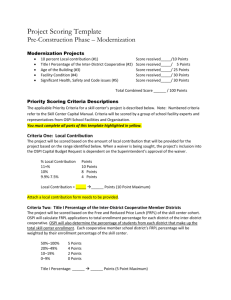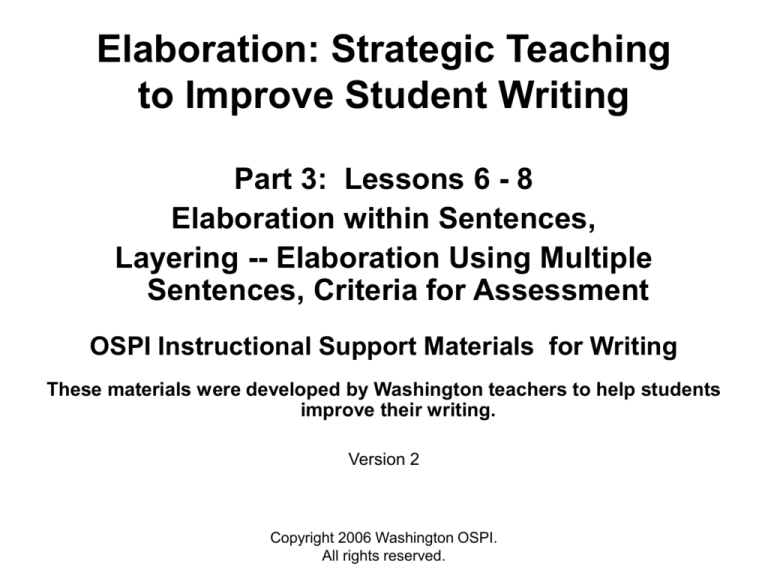
Elaboration: Strategic Teaching
to Improve Student Writing
Part 3: Lessons 6 - 8
Elaboration within Sentences,
Layering -- Elaboration Using Multiple
Sentences, Criteria for Assessment
OSPI Instructional Support Materials for Writing
These materials were developed by Washington teachers to help students
improve their writing.
Version 2
Copyright 2006 Washington OSPI.
All rights reserved.
OSPI Writing Instructional Support Materials
Core Development Team
Nikki Elliott-Schuman – OSPI, Project Director
Charlotte Carr – Retired Seattle SD, Facilitator
Barbara Ballard – Coupeville SD
Anne Beitlers – Seattle SD
Marcie Belgard – Richland SD
Betsy Cornell – Moses Lake SD
Lydia Fesler – Spokane SD
Lori Hadley – Puyallup SD
Lissa Humphreys – East Valley SD (Spokane)
Kathleen McGuinness – Kennewick SD
Lisa McKeen – East Valley SD (Yakima)
Sharon Schilperoort – Yakima SD
Holly Stein – Eastside Catholic High School
Copyright 2006 Washington OSPI.
All rights reserved.
Purpose
To share teaching strategies that will help
students develop a piece of writing that
elaborates on a single idea and addresses
the needs and interests of a particular
audience.
Elaboration is critical for clear and
effective writing.
Copyright 2006 Washington OSPI.
All rights reserved.
Elaboration Module
Series of Lessons
•
•
•
•
•
•
•
•
Defining Elaboration
Asking Questions that Lead to Elaboration
Recognizing Elaboration
Show, Don't Tell
Specific, Concrete Details versus General Language
Elaboration within Sentences
Layering -- Elaboration Using Multiple Sentences
Criteria for Assessment
Copyright 2006 Washington OSPI.
All rights reserved.
ELABORATION WITHIN
SENTENCES
Lesson 6
Copyright 2006 Washington OSPI.
All rights reserved.
Elaboration within a Sentence
• Sentences can be expanded by adding
elaboration.
• Sentences can be combined to provide
elaboration.
TELL
ME
MORE. . .
Lesson 6
APPOSITIVES, PHRASES,
AND CLAUSES.
Copyright 2006 Washington OSPI.
All rights reserved.
Appositives
Add information to a single sentence.
Lesson 6
Copyright 2006 Washington OSPI.
All rights reserved.
Appositives
• An appositive is a noun or noun phrase that
follows another noun or pronoun that renames it
or adds information.
• An appositive is usually set apart from the
sentence by commas.
• Joel made the goal.
Joel, the star
of the
made the goal.
Sentence
withteam,
an appositive.
Lesson 6
Copyright 2006 Washington OSPI.
All rights reserved.
Appositives answer the reader’s
questions.
Mom---Natalya is
coming over
tonight.
Who is Natalya?
Natalya, the girl who
sits beside me in
band, is coming over
tonight.
Lesson 6
Copyright 2006 Washington OSPI.
All rights reserved.
Add an appositive to a
sentence.
WHO ?
• Ms. Ortega, ____________, is my teacher.
• Ms. Ortega, English teacher in room 7,
is my teacher.
WHERE ?
• Crystal Lake, ___________,
is my home.
• Crystal Lake, a lovely town off Interstate
90, is my home.
Lesson 6
Copyright 2006 Washington OSPI.
All rights reserved.
Elaborate by adding
appositives.
Try adding an appositive with a partner.
• My school, ______________, is the best.
• That lunch, ____________,was the worst.
• Mrs. Dennis, ____________, helped me
find a site on the Internet.
• My car, __________, is a piece of junk.
Lesson 6
Copyright 2006 Washington OSPI.
All rights reserved.
Some Samples
• My school, the largest school in our town, is the
best.
• That lunch, liver, onions, and ketchup, was the
worst.
• Mrs. Dennis, our new librarian , helped me find a
site on the Internet.
• My car, an ancient jalopy inherited from my
brother, is a piece of junk.
Lesson 6
Copyright 2006 Washington OSPI.
All rights reserved.
Combine sentences to form an
appositive.
We can combine the two following sentences into one
power-packed sentence and delete unnecessary words.
• John plays varsity basketball for the
Springfield Hurricanes basketball team.
• He is a senior and the point guard for his
team.
John, the senior point guard, plays
basketball for the Springfield Hurricanes.
Lesson 6
Copyright 2006 Washington OSPI.
All rights reserved.
More Practice Combining
Sentences to Form Appositives
Look at the two sentences. Choose one of the
sentences to be the base sentence and using the
important information from the other sentence, write an
appositive.
• Trevor owns and operates Screaming TShirts.
• Trevor owns his own business.
Trevor, the owner, operates the business
Screaming T-Shirts.
Lesson 6
Copyright 2006 Washington OSPI.
All rights reserved.
Elaborate by combining sentences.
More practice
• Emily bought a present for her best friend at Macy’s.
• Emily bought a silver ring for her best friend.
________________________________________
• Alex ran around the track 25 times that morning.
• Alex is a marathon runner from Yacoco High School.
Lesson 6
Copyright 2006 Washington OSPI.
All rights reserved.
Prepositional Phrases
• A prepositional phrase adds information and
elaboration by answering questions a reader
may have.
• Prepositional phrases are often used to answer
questions about position, place, location, or time.
(examples of prepositions - by, of, for, on, in, under, with, through,
beside, before, after, during…)
Lesson 6
Copyright 2006 Washington OSPI.
All rights reserved.
Phrases add elaboration.
Example
• Susie, a senior at Springfield High, runs the
concession stand.
When does Susie
run the concession
stand?
Why does she run it?
• Susie, a senior at Springfield High, runs the
concession stand for every 2005-6 basketball
game.
Lesson 6
Copyright 2006 Washington OSPI.
All rights reserved.
Your Turn to Add Prepositional
Phrases
• With your partner, add prepositional
phrases to the following sentences to
answer questions a reader may have.
• Luis got his driving license.
• Maryann earned an academic award.
• Nadia came in first place.
Lesson 6
Copyright 2006 Washington OSPI.
All rights reserved.
Clauses add elaboration.
Definition
• A clause is a group of words that
depends on a complete sentence and
starts with an introductory word such
as who, which, that, although, since, or
because and has its own subject and
verb.
Lesson 6
Copyright 2006 Washington OSPI.
All rights reserved.
Clauses add elaboration.
Example
• Elaine had plenty of her own money.
• Elaine asked her friend Delia to pay for
her movie ticket.
Combined with a clause
Although Elaine had plenty of her own money,
she asked her friend Delia to pay for her
movie ticket.
Lesson 6
Copyright 2006 Washington OSPI.
All rights reserved.
Another Example
Example
• Maryann and Jocelyn were both late
getting home.
• The party lasted longer than planned.
Combined with a clause
Because the party lasted longer than planned, Maryann
and Jocelyn were both late getting home.
Lesson 6
Copyright 2006 Washington OSPI.
All rights reserved.
One More Example
Example
• Gabriel had a flat tire on Snoqualmie Pass.
• He was rescued by a state patrolman.
Combined with a clause
Gabriel, who had a flat tire on Snoqualmie Pass,
was rescued by a state patrolman.
OR
When Gabriel had a flat tire on Snoqualmie Pass,
he was rescued by a state patrolman.
Lesson 6
Copyright 2006 Washington OSPI.
All rights reserved.
Your turn to elaborate with clauses.
Combine the following pairs of sentences using
clauses.
• Benjamin and Gerardo walked home after the
football game.
• Celia offered Benjamin and Gerardo a ride
home after the Friday night football game.
___________________________________
• Josh went to take his driving test.
• Josh failed his driving test two times.
Lesson 6
Copyright 2006 Washington OSPI.
All rights reserved.
Elaboration Module
Series of Lessons
•
•
•
•
•
•
•
•
Defining Elaboration
Asking Questions that Lead to Elaboration
Recognizing Elaboration
Show, Don't Tell
Specific, Concrete Details versus General Language
Elaboration within Sentences
Layering -- Elaboration Using Multiple Sentences
Criteria for Assessment
Copyright 2006 Washington OSPI.
All rights reserved.
LAYERING vs. LISTING
Lesson 7
Copyright 2006 Washington OSPI.
All rights reserved.
Layering Elaboration
A thoughtful writer layers one sentence after
another.
Each new sentence adds to or develops the
thought
. . .like rings around
a bull’s-eye.
Lesson 7
Copyright 2006 Washington OSPI.
All rights reserved.
Layering seems like
• Each idea is carefully stacked
on the next. . . like bricks in a wall
. . .or rings on a tall tree.
Lesson 7
Copyright 2006 Washington OSPI.
All rights reserved.
Every sentence and detail fit with
the rest of the topic
. . .like a set of nesting dolls.
Lesson 7
Copyright 2006 Washington OSPI.
All rights reserved.
Listing vs. Layering
• Don’t add boring, list-like sentences just to make
the paragraph longer.
• REMEMBER – length doesn’t always mean
quality elaboration.
List-like example rather than layering Having lots of choices is the reason why I eat at school.
I love nachos. I like the pizza at school. Sometimes I
order salad when I am feeling full. I have some favorite
vegetables.
See - Choices-listing.doc, Choices-layering.doc
Lesson 7
Copyright 2006 Washington OSPI.
All rights reserved.
Layering sounds like
TOPIC
Having lots of food choices is the reason why I like
my school’s lunchroom.
I can select my favorite foods for lunch everyday. I
sometimes pick cheesy nachos with the melted cheese
sauce smothered over the hot crispy chips. If I don’t
want anything that greasy, like nachos or pizza, I can
choose a “made-for-me” salad. This means I get to
choose what goes on it and my favorite veggies,
including olives, peppers, and tomatoes. The best thing
is I can pick a food that fits my attitude that day.
Lesson 7
Copyright 2006 Washington OSPI.
All rights reserved.
Another layering example
TOPIC
Skiing down a Black Diamond run gives a
rush like no other. What appears like a peaceful
sport is really a contrast to the 50 mph feel of the
wind in your face, waist-high moguls to weave in
and out of while your thighs scream, “Stop!” With
a wind chill of minus 10, you still have sweat
dripping under your long johns as your
adrenaline pumps through your veins. You can’t
wait to get to the bottom of the run and do it
again.
Lesson 7
Copyright 2006 Washington OSPI.
All rights reserved.
Practice layering.
• Read the following topic sentence. With a
partner take turns adding layers of
sentences that DEVELOP the topic.
Dessert is my favorite thing to order
at McDonald’s.
See student sample Dessert at McDonald’s
Lesson 7
Copyright 2006 Washington OSPI.
All rights reserved.
More Practice with Layering
In the following paragraph, discuss how all the
sentences layer or develop the topic.
Football season at JKHS is the best time of the year.
Even though I don’t play, football provides us all with
something to do on Friday nights. Sometimes that
means watching the football games; sometimes that
means the after-game dance. My favorite football
memory was after the game with MLHS. The ASB
leaders made a huge bonfire for us to celebrate the win.
It lasted until 2:00 a.m. when we went to Shari’s for
breakfast to plan the next football experience.
Lesson 7
Copyright 2006 Washington OSPI.
All rights reserved.
Remember…layering looks like
• Sentences thoughtfully placed with the
one main topic threaded through them
. . . purposely
explaining with
the needs of the
audience in mind.
Lesson 7
Copyright 2006 Washington OSPI.
All rights reserved.
Your Turn
Choose one of the following two topics. Then write a
paragraph and practice elaborating by layering
each sentence and developing the main idea.
The parking lot at _______ High is where the real
education takes place at school.
_______ is what I live for on the weekends.
Lesson 7
Copyright 2006 Washington OSPI.
All rights reserved.
Elaboration Module
Series of Lessons
•
•
•
•
•
•
•
•
Defining Elaboration
Asking Questions that Lead to Elaboration
Recognizing Elaboration
Show, Don't Tell
Specific, Concrete Details versus General Language
Elaboration within Sentences
Layering -- Elaboration Using Multiple Sentences
Criteria for Assessment
Copyright 2006 Washington OSPI.
All rights reserved.
CRITERIA FOR
ASSESSMENT
Lesson 8
Copyright 2006 Washington OSPI.
All rights reserved.
Scoring Guide for Elaboration
• Teachers and students should use the
Elaboration Scoring Guide to evaluate
students’ writing for elaboration.
See - Elaboration Scoring Guide
Lesson 8
Copyright 2006 Washington OSPI.
All rights reserved.
Checklist for Elaboration
• Teachers and students should read the
checklist and may use it as an alternative
tool to evaluate writing.
•
Lesson 8
See - Elaboration Checklist
Copyright 2006 Washington OSPI.
All rights reserved.
After Reading the Checklist
• If any bullet has a NO marked in your
writing, this is the time
– To revise and add more and/or different types
of elaboration.
– To consider carefully why you chose to leave
something out.
Lesson 8
Copyright 2006 Washington OSPI.
All rights reserved.
Feedback, please
We welcome your comments. Please feel
free to try these lessons and send
feedback to Nikki Elliott-Schuman at
nelliott@ospi.wednet.edu. We appreciate
your labeling the subject line as Feedback:
OSPI Instructional Support Materials.
Copyright 2006 Washington OSPI.
All rights reserved.

